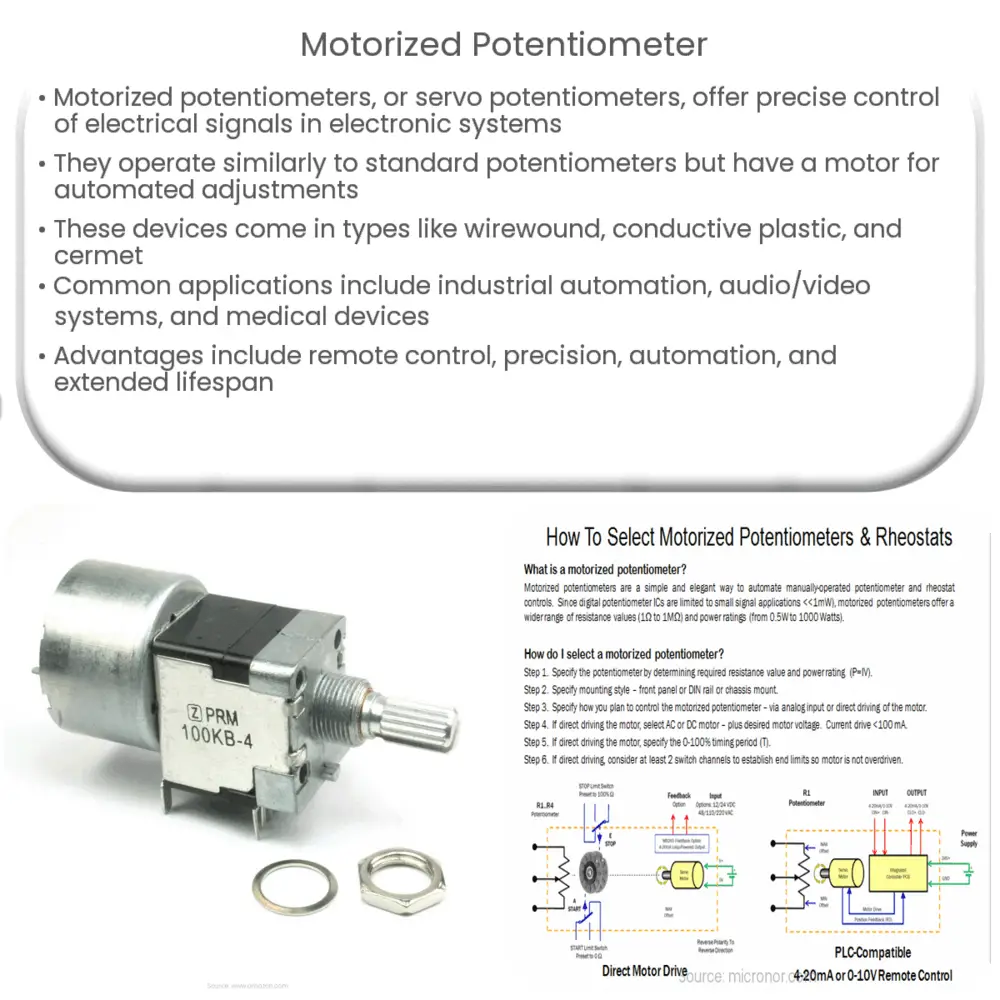A motorized potentiometer is an electronic component that enables precise remote control of voltage or current levels in various applications.

Motorized Potentiometer: A Comprehensive Overview
Introduction
A motorized potentiometer, also known as a servo potentiometer, is an essential device in various electronic systems, providing precise control and measurement of electrical signals. These potentiometers are capable of automatic adjustments via a motor, ensuring accurate and reliable results. This article aims to provide a comprehensive understanding of motorized potentiometers, their working principles, applications, and advantages over traditional potentiometers.
Working Principle
A motorized potentiometer operates on the same fundamental principles as a standard potentiometer. It consists of a resistive element, a sliding contact or wiper, and a motor that moves the wiper along the resistive element. As the wiper moves, it changes the resistance between the input and output terminals, allowing for the adjustment of the output voltage or current. The motorized potentiometer’s key distinction is the motor, which automates the wiper’s movement and enables precise and remote control of the potentiometer’s position.
The motor can be either a stepper motor or a DC motor, depending on the application and desired level of precision. Stepper motors are preferred for their higher accuracy and ability to hold the wiper’s position without drifting, while DC motors are used for applications where speed and simplicity are prioritized over precision.
Types of Motorized Potentiometers
Motorized potentiometers come in various types, based on their design and construction. Some common types include:
- Wirewound potentiometers: These potentiometers use a resistive wire wound around an insulating core. They offer high power handling capabilities, low noise, and excellent stability. However, they may exhibit a non-linear resistance change due to their winding nature.
- Conductive plastic potentiometers: These potentiometers use a resistive material, usually carbon, deposited on a substrate. They offer a smooth, continuous resistance change, and can provide higher resolution and linearity compared to wirewound potentiometers. However, they have lower power handling capabilities and can be more susceptible to wear and noise.
- Cermet potentiometers: These potentiometers are made from a blend of ceramic and metallic materials, offering high-temperature stability, excellent linearity, and low noise. They are suitable for applications that require high precision and reliability.
Applications
Motorized potentiometers find applications in a wide range of industries, including:
- Industrial automation: They are used to control motors, drives, and other equipment requiring precise voltage or current adjustments.
- Audio and video equipment: Motorized potentiometers are used in high-end audio and video systems for remote volume control and signal adjustments.
- Medical devices: They provide precise control in medical equipment, such as infusion pumps, ventilators, and diagnostic devices.
Advantages of Motorized Potentiometers
Motorized potentiometers offer several advantages over traditional potentiometers, making them a valuable addition to various applications. Some of the key benefits include:
- Remote control: With motorized potentiometers, users can make adjustments remotely, eliminating the need for manual intervention. This is particularly useful in situations where the potentiometer is located in an inaccessible or hazardous area.
- Precise control: The motor-driven wiper ensures accurate positioning, allowing for precise adjustments to the output voltage or current. This level of precision is crucial in applications that demand high levels of accuracy and repeatability.
- Automation: The integration of a motorized potentiometer into an automated system allows for the potentiometer’s position to be controlled programmatically, streamlining processes and reducing the risk of human error.
- Longevity: Motorized potentiometers typically have a longer operational life than their manual counterparts, as the motor’s controlled movement reduces wear and tear on the wiper and resistive element.
Selection Criteria
When selecting a motorized potentiometer for a specific application, several factors need to be considered to ensure optimal performance and reliability. These factors include:
- Resistance range: Choose a potentiometer with a resistance range suitable for the application. The desired output voltage or current will dictate the required resistance range.
- Motor type: Select a motor type (stepper or DC) that meets the requirements for precision, speed, and complexity of the application.
- Linearity and resolution: Evaluate the linearity and resolution of the potentiometer to ensure it meets the desired level of accuracy and precision for the specific application.
- Power rating: Consider the power handling capabilities of the potentiometer to ensure it can safely manage the power levels in the application without overheating or failure.
- Environmental factors: Take into account the operating temperature, humidity, and potential exposure to contaminants or corrosive substances when selecting a motorized potentiometer.
Conclusion
Motorized potentiometers have become an integral component in numerous electronic systems, providing precise control and measurement of electrical signals. Their ability to offer remote control, automation, and enhanced precision has made them indispensable in various applications, such as industrial automation, audio and video equipment, and medical devices. By considering factors such as resistance range, motor type, linearity, resolution, power rating, and environmental factors, users can select the most suitable motorized potentiometer for their specific application, ensuring reliable and accurate performance.

